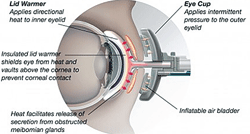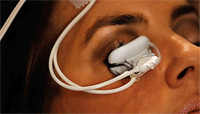 Over the past six years of writing this column, we’ve published numerous articles that have discussed dry eye and meibomian gland dysfunction (MGD). For one of us (Dr. Kabat), this field of study is a passion. For the other (Dr. Sowka), it is an all-too-common patient complaint, and a potential barrier to effective long-term glaucoma therapy.
Over the past six years of writing this column, we’ve published numerous articles that have discussed dry eye and meibomian gland dysfunction (MGD). For one of us (Dr. Kabat), this field of study is a passion. For the other (Dr. Sowka), it is an all-too-common patient complaint, and a potential barrier to effective long-term glaucoma therapy.
There have been—and will continue to be—numerous strategies for dry eye management. These include simple lubrication therapy, nutritional intervention, the use of topical pharmaceutical agents and even surgical procedures such as conjunctivoplasty.1 However, with the recognition of MGD as perhaps the most frequent cause of dry eye disease, our attention recently has turned to new ways to manage this old adversary.2
Classic MGD Management
One of the most well-established and widely accepted MGD treatments involves lid hyperthermia (e.g., warm compresses) combined with digital massage to help express sequestered meibum from the glands.
Indeed, some experts maintain that, despite the recent introduction of topical immunomodulatory agents and even direct probing of meibomian glands, the use of heat and therapeutic gland expression is the best and most practical treatment option for MGD.3-7
Of course, the classic technique of using warm compresses on a daily basis can be cumbersome, disruptive and tedious for many patients, and clinicians realize that such prescribed treatment often fails because of poor compliance. To that end, a variety of devices have been developed to help facilitate this therapy.8-13
A Better Mousetrap
In our high-tech society, patients may have little faith in something as simple as hot compresses, but may readily gravitate to a new “device.” One recent innovation, the LipiFlow Thermal Pulsation System (TearScience, Inc.), first garnered the attention of the general eye care community about 18 months ago, following the publication of a case report in Cornea.13

Diagram of the LipiFlow Thermal Pulsation System
The article detailed the case of a 39-year-old patient with severe evaporative dry eye secondary to MGD who was treated with a prototypical device, which was designed to alleviate meibomian gland obstruction through a combination of precision-controlled heat delivery and pulsating pressure on the eyelids.13
According to the study, a single, 12-minute treatment session per eye successfully restored function in 33% of the individual meibomian glands, doubled the tear film break-up time, and decreased symptom scores by approximately 80% for the entire follow-up period of three months.13
Then, about a year ago, a second publication reported the results of 14 subjects enrolled in a multicenter trial that utilized the same device.14
Once again, the treatment successfully improved meibomian gland secretions and expressibility, tear film break-up time, corneal staining and the overall symptom score beyond the three-month follow-up.14
Larger studies of a longer duration (that are not yet published) show similar efficacy and even longer maintenance of therapeutic effect. According to information obtained from TearScience, a sub-cohort of 30 patients was followed for one year after a single LipiFlow session. The subjects continued to show statistically significant improvements in mean meibomian gland secretion scores, mean tear film break-up time and subjective symptoms (based on the Standard Patient Evaluation of Eye Dryness [SPEED] and Ocular Surface Disease Index [OSDI] questionnaires) at both nine- and 12-month follow-up.15,16
How Does it Work?
What makes the LipiFlow system unique is its design. Although it employs nothing more than directed heat and massage to achieve its effect, LipiFlow exhibits a remarkable feat of engineering as well as a revolutionary approach to this seemingly antiquated form of therapy. The first distinctive feature of this system is the inclusion of a heating element that is directed toward the meibomian glands from the palpebral side (inside) of the lid, rather than the dermal side. This is a logical consideration, because the glands are physically situated much closer to the conjunctival surface than to the skin of the lids.
Several years ago, researchers dissected the issue of warm compresses for the treatment of MGD in an effort to determine the precise temperature and duration necessary to render a therapeutic impact on the meibomian gland secretions. They concluded that patients needed to achieve and maintain a temperature of 45°C (113°F) for at least four minutes on the outer lid surface several times daily to be even somewhat effective.17

External view of the LipiFlow Thermal Pulsation System.
Additionally, the authors indicated that conventional warm compress therapy, while beneficial, is difficult if not entirely impractical for most patients.17 The LipiFlow device addresses the physical limitations of heating the inner eyelid surfaces by employing a large shell (similar to a scleral lens) that contains both warming and insulating components.
It is designed to safely and comfortably vault the cornea and direct constant, controlled heat to the glands while protecting the surfaces both in proximity of and in contact with the device. The instrument may be inserted very easily, much like a gonioscopy lens. The shell then maintains a consistent temperature of exactly 42.5ºC (109°F) around the inner surface of the eyelids, which has been shown to effectively heat all of the meibomian glands in both the upper and lower lids.13
The instrument’s second major component is an inflatable silicone air bladder that covers the external surface of the eyelid after the device has been inserted. During the 12-minute treatment cycle, the bladder inflates and deflates rhythmically—applying pressure from the distal region of the lids to the proximal region near the lid margins, which simulates the motion that is recommended for gland self-expression.
Both the upper and lower lids are squeezed simultaneously between the inner heated surface of the shell and the outer air bladders, which expresses the sequestered meibum from the glands in a precise, controlled fashion.
Still New to the U.S.
The LipiFlow Thermal Pulsation System has been available in Europe and Canada for some time, but just recently received FDA approval in July 2011. The instrument is still not widely available because of its high price tag.
Still, noted experts who have worked with the device are extremely positive. Alan N. Carlson, M.D., chief of Cornea, External Disease and Refractive Surgery Services at Duke University Eye Center, was an early supporter and remains a strong advocate for the LipiFlow system, as does Stephen S. Lane, M.D., managing partner of Associated Eye Care in St. Paul and adjunct clinical professor at the University of Minnesota in Minneapolis.18,19
Of course, the most compelling part of this treatment seems to be its endurance. If future studies confirm the early research, it may eventually be possible to treat MGD and evaporative dry eye with brief, periodic in-office therapy rather than relying on a variety of daily, patient-initiated interventions.
While there is no “magic bullet” for patients with dry eye, new innovations allow us to achieve improved results with a larger percentage of our patients. Only by staying abreast of the latest treatments and technologies can we remain competitive in the ever-changing field of eye care.
Drs. Kabat and Sowka have no direct financial interest in any of the products or companies mentioned in this article.
1. Hara S, Kojima T, Ishida R, et al. Evaluation of tear stability after surgery for conjunctivochalasis. Optom Vis Sci. 2011 Sep;88(9):1112-8.
2. Nichols KK, Foulks GN, Bron AJ, et al. The international workshop on meibomian gland dysfunction: Executive summary. Invest Ophthalmol Vis Sci. 2011 Mar 30;52(4):1922-9.
3. Perry HD, Doshi-Carnevale S, Donnenfeld ED, et al. Efficacy of commercially available topical cyclosporine A 0.05% in the treatment of meibomian gland dysfunction. Cornea. 2006 Feb;25(2):171-5.
4. Foulks GN, Borchman D, Yappert M, et al. Topical azithromycin therapy for meibomian gland dysfunction: clinical response and lipid alterations. Cornea. 2010 Jul;29(7):781-8.
5. Opitz DL, Tyler KF. Efficacy of azithromycin 1% ophthalmic solution for treatment of ocular surface disease from posterior blepharitis. Clin Exp Optom. 2011 Mar;94(2):200-6.
6. Maskin SL. Intraductal meibomian gland probing relieves symptoms of obstructive meibomian gland dysfunction. Cornea. 2010 Oct;29(10):1145-52.
7. Blackie CA, Korb DR, Knop E, Bedi R, Knop N, Holland EJ. Non-obvious obstructive meibomian gland dysfunction. Cornea. 2010 Dec;29(12):1333-45.
8. Goto E, Monden Y, Takano Y, et al. Treatment of non-inflamed obstructive meibomian gland dysfunction by an infrared warm compression device. Br J Ophthalmol. 2002 Dec;86(12):1403-7.
9. Mori A, Shimazaki J, Shimmura S, et al. Disposable eyelid-warming device for the treatment of meibomian gland dysfunction. Jpn J Ophthalmol. 2003 Nov-Dec;47(6):578-86.
10. Mitra M, Menon GJ, Casini A, et al. Tear film lipid layer thickness and ocular comfort after meibomian therapy via latent heat with a novel device in normal subjects. Eye (Lond). 2005 Jun;19(6):657-60.
11. Matsumoto Y, Dogru M, Goto E, et al. Efficacy of a new warm moist air device on tear functions of patients with simple meibomian gland dysfunction. Cornea. 2006 Jul;25(6):644-50.
12. Ishida R, Matsumoto Y, Onguchi T, et al. Tear film with “Orgahexa EyeMasks” in patients with meibomian gland dysfunction. Optom Vis Sci. 2008 Aug;85(8):684-91.
13. Korb DR, Blackie CA. Restoration of meibomian gland functionality with novel thermodynamic treatment device-a case report. Cornea. 2010 Aug;29(8):930-3.
14. Friedland BR, Fleming CP, Blackie CA, Korb DR. A novel thermodynamic treatment for meibomian gland dysfunction. Curr Eye Res. 2011 Feb;36(2):79-87.
15. Greiner JV. A single LipiFlow Thermal Pulsation System treatment improves meibomian gland function and reduces dry eye symptoms for 9 months. Poster presented at the American Academy of Ophthalmology meeting: October 16-19, 2010. Chicago.
16. Majmudar PA, Greiner JV, Bedi R. In a multicenter study, a single LipiFlow treatment improves meibomian gland secretion and reduces dry eye symptoms for 1 month. Poster presented at the Association for Research in Vision and Ophthalmology (ARVO) meeting: May 2-6, 2010. Fort Lauderdale, Florida.
17. Blackie CA, Solomon JD, Greiner JV, et al. Inner eyelid surface temperature as a function of warm compress methodology. Optom Vis Sci. 2008 Aug;85(8):675-83.
18. Carlson AN. A new paradigm for treating dry eye patients. Advanced Ocular Care. 2010 Oct;1(7):37-41.
19. Lane SS. A paradigm shift in the treatment of meibomian gland dysfunction. Digital Supplement—Innovations in Ophthalmology 2011. Available at: http://bmctoday.net/innovations2011/digital_supplement (accessed January 13, 2012).

